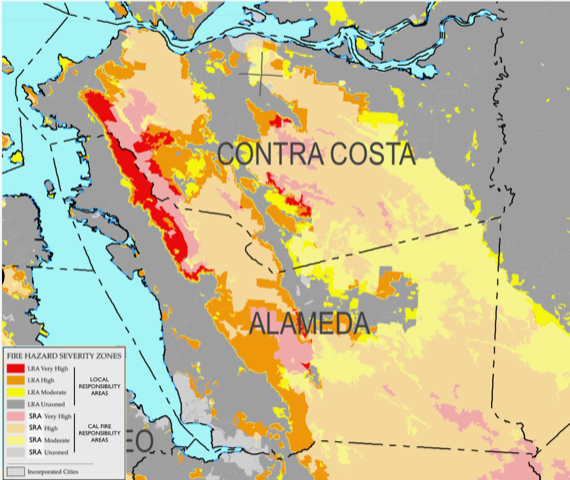It is time for a new, more effective, regional approach if the East Bay Hills are to be safe from future wildfires. Using the Joint Powers Authority process to address the wildfire threat posed by inadequate vegetation management in the hills of Alameda and Contra Costa counties makes sense.
Today, local government agencies are responsible for preventing and fighting wildfires in urbanized areas and counties are responsible for unincorporated areas. But wildfires cross jurisdictional boundaries, involving multiple cities and counties.
Wildfires move at hurricane speeds and force, with winds from 60 to 100 mph, fast enough to jump huge freeways. It took only one hour for the Berkeley Oakland Tunnel Fire to move from the Berkeley Hills across the Highway 24 freeway to destroy homes in the Upper Rockridge area of Oakland. To the north, it took only four hours for the Tubbs Fire to move from the Napa Valley to Santa Rosa. To the south, the Thomas Fire moved from Ventura to Santa Barbara, jumping a 15-lane freeway. Once started, extinguishing wildfires often is no longer possible, leaving evacuation as the only answer. Evacuation times are often measured in minutes, or less.
Since they are impossible to stop once they get going, preventing wildfires becomes our only choice. In Alameda County alone, there are 14 separate cities. If vegetation in our area is to be well-managed to reduce the threat of wildfire, the necessary expertise, workforce and financial resources must be assembled over a broad enough area to be effective. Local agencies with all their present responsibilities unfortunately lack sufficient breadth and resources to adequately address the problem. Coordinating vegetation management among all the East Bay local public agencies is an impossible challenge withou a mechanism to lead that effort.
Just as we have special districts in the Bay Area to manage air quality, water quality and regional planning and transportation, it is time to create a wildfire prevention district to manage vegetation and dramatically reduce the fuel that causes the spread of wildfires in our wildland urban interface. Local government agencies in Alameda and Contra Costa counties can create a joint powers authority to accomplish this.
An East Bay Wildfire Prevention and Vegetation Management Agency would
(1) Develop a plan to reduce the most flammable wildlands vegetation in the East Bay Hills to the maximum extent feasible and to replace it with wildfire resistant vegetation where appropriate.
(2) The plan would protect sensitive wildlife habitats and native plant landscapes.
(3) The plan would include a “Defensible Space” program to aid owners of private property with information resources to manage vegetation on their properties.
(4) The plan would include a “Home Hardening” program to advise homeowners, schools and commercial property owners on how their structures can be protected from wildfires.
5) Raise funds by applying for state and federal grants, preparing tax measures for voter approval and other means permitted by law.
6) Implement the plan by retaining sufficient staff and equipment and/or by contracting with others to remove the most flammable vegetation in wildland areas and to implement the public information programs for defensible space and home hardening. An added benefit of a district that addresses this problem may be that the current difficulties many property owners are facing with either cancellation of their homeowner insurance polices or huge rate increases due to inreased fire risks would be lessened.
The Oakland Firesafe Council and other wildfire advocacy organizations is raising seed funds to launch such a JPA We have hired a consulting firm to work with the cities, counties and other interested parties in hammering out the details of an East Bay Regional Wildfire Prevention Vegetation Management Joint Powers Authority.You can support that effort by donating to our JPA Seed Fund here.
Donate to the JPA Seed Fund Today!
Or write checks to:
Oakland Firesafe Council
6114 La Salle Avenue, Suite 462
Oakland, CA 94611
As a 501c3 nonprofit corporation, your checks are tax-deductible!


